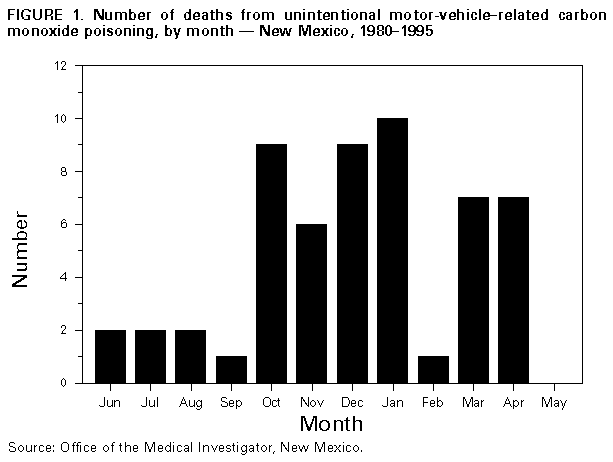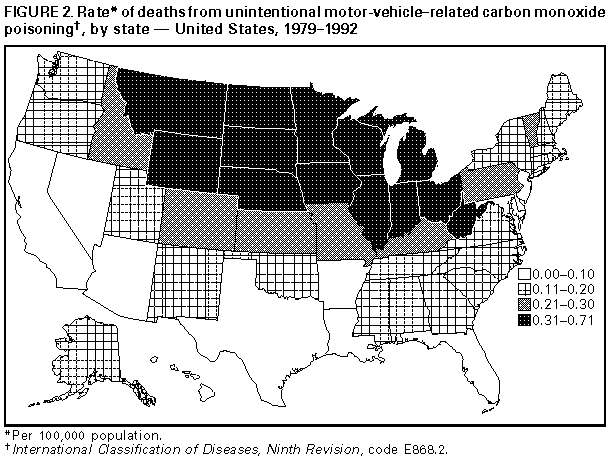 |
|
|
|
|
|
|
| ||||||||||
|
|
|
|
|
|
|
||||
| ||||||||||
|
|
|
|
|
Persons using assistive technology might not be able to fully access information in this file. For assistance, please send e-mail to: mmwrq@cdc.gov. Type 508 Accommodation and the title of the report in the subject line of e-mail. Deaths from Motor-Vehicle Related Unintentional Carbon Monoxide Poisoning Colorado, 1996, New Mexico, 1980 1995, and United States, 1979 1992Carbon monoxide (CO) is a colorless, odorless, toxic gas that is a product of incomplete combustion. Motor vehicles, heaters, and appliances that use carbon-based fuels are the main sources of this poison. Most fatal unintentional CO poisonings associated with motor vehicles are preventable and can result from differing mechanisms of exposure: 1) operation of a motor vehicle with a damaged or malfunctioning exhaust system and an inadequately ventilated passenger compartment, 2) operation of a motor vehicle in an enclosed space (e.g., a garage) with inadequate ventilation, and 3) use of auxiliary fuel-burning heaters inside a passenger compartment or in a camper (1 8). This report describes the investigation of deaths associated with multiple motor-vehicle related CO poisonings in Colorado on November 3, 1996, summarizes a review of such deaths in New Mexico during 1980 1995, and presents geographic and seasonal patterns in national death rates for 1979 1992. These findings indicate that deaths from motor- vehicle related unintentional CO poisonings increase during winter months and that death rates from CO poisoning in stationary motor vehicles are highest in states with colder average winter temperatures. Colorado On November 3, 1996, five men aged 17 22 years were found dead inside two automobiles with the engine of one car running inside a garage with closed doors and windows. Friends and relatives of the decedents reported that on the night of November 2, the men had been out consuming alcohol and continued socializing in the garage after they had returned home. In an apparent attempt to keep warm, they had entered the cars, started the engine of one car, and turned on the heat. New Mexico During 1980 1995, a total of 56 motor-vehicle related CO poisoning deaths occurred in New Mexico: 24 (43%) were caused by the combination of a faulty exhaust system and an inadequately ventilated passenger compartment; 22 (39%), by operation of a motor vehicle inside an improperly ventilated structure; and 10 (18%), by the use of a fuel-burning heating device inside an inadequately ventilated passenger compartment. During this period, the number of deaths increased sharply during October and peaked during December January (Figure_1). National Death Rates National mortality data (underlying cause of death) for 1979 1992 were used to calculate death rates for CO poisoning in stationary motor vehicles (International Clas-sification of Diseases, Ninth Revision {ICD-9}, code E868.2). Data about nonstationary vehicular CO poisoning (ICD-9 code E818) were excluded from the analysis. Death rates from CO poisoning were higher in most states in the northern regions of the United States, where winter temperatures are coldest, than in states in southern regions, which have warmer winter temperatures (Figure_2). Reported by: RE Zumwalt, MD, Office of the Medical Investigator, New Mexico. M Cook Wake, MS, Injury Epidemiology; R Hoffman, MD, State Epidemiologist, Colorado Dept of Public Health and Environment. RF Malesich, Lake County Coroner's Office, Leadville, Colorado. Surveillance and Programs Br, Air Pollution and Respiratory Health Br, Div of Environmental Hazards and Health Effects, National Center for Environmental Health, CDC. Editorial NoteEditorial Note: The findings in this report underscore that most fatal motor-vehicle related CO poisonings occur in northern states and during the colder months (1,4 8). The CO in motor-vehicle exhaust accounts for the most poisoning deaths in the United States caused by a single agent (8). Of the 11,547 unintentional CO deaths during 1979 1988, 57% were caused by motor-vehicle exhaust; of these, 83% were associated with stationary vehicles (1). Most motor-vehicle related CO deaths in garages have occurred even though the garage doors or windows have been open (6), suggesting that passive ventilation may not be adequate to reduce risk in semi-enclosed spaces. Deaths also have occurred in working or living quarters adjacent to enclosed garages with vehicular sources of CO (8). CO intoxication and resulting tissue hypoxia affect multiple organ systems. Manifestations associated with CO exposure range from subtle neuropsychologic signs and symptoms to coma and death and can include headache, dizziness, fatigue, weakness, drowsiness, nausea, vomiting, loss of consciousness, skin pallor, dyspnea on exertion, palpitation, confusion, irritability, and irrational behavior (9). Strategies for primary prevention of CO poisoning emphasize limiting CO emissions from known sources and include testing vehicular emissions, inspecting exhaust systems, conducting information and media campaigns with messages about the dangers of vehicular exhaust in enclosed spaces (especially during the colder months), and targeting culturally diverse populations who, because of language barriers, may be unaware of the sources and fatal consequences of CO exposure (10). Secondary prevention efforts, which focus on early detection of potentially toxic exposures, have not been established for motor-vehicle related CO poisonings and, although CO detectors are widely available, there are no standard recommendations for their use. Although CO detector technology continues to evolve, detectors should not substitute for proper use, inspection, and maintenance of fuel-burning devices. References
Figure_1  Return to top. Figure_2  Return to top. Disclaimer All MMWR HTML versions of articles are electronic conversions from ASCII text into HTML. This conversion may have resulted in character translation or format errors in the HTML version. Users should not rely on this HTML document, but are referred to the electronic PDF version and/or the original MMWR paper copy for the official text, figures, and tables. An original paper copy of this issue can be obtained from the Superintendent of Documents, U.S. Government Printing Office (GPO), Washington, DC 20402-9371; telephone: (202) 512-1800. Contact GPO for current prices. **Questions or messages regarding errors in formatting should be addressed to mmwrq@cdc.gov.Page converted: 09/19/98 |
|||||||||
This page last reviewed 5/2/01
|